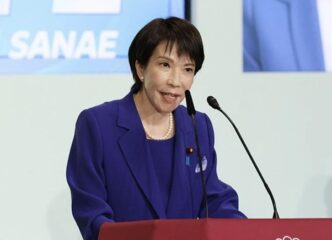
Japan is poised to make history as Sanae Takaichi, a veteran conservative lawmaker, wins the leadership race of the ruling Liberal Democratic Party (LDP), setting her on course to become the nation’s first female prime minister.
Takaichi, 64, triumphed in the runoff vote of the LDP presidential election held on October 4, defeating her younger rival, 44-year-old Shinjiro Koizumi, in a closely contested race. She garnered 185 votes against Koizumi’s 156.
The leadership election was called after Prime Minister Shigeru Ishiba announced his resignation in September, following two major election losses under his administration. An extraordinary Diet session will be convened on October 15, where Takaichi is expected to be formally elected as prime minister.
A Historic Victory – Sanae Takaichi
Takaichi’s victory marks a watershed moment in Japan’s political history, breaking the long-standing male dominance in the country’s top leadership position. Despite the ruling coalition lacking a majority in either chamber of the Diet, the fragmented opposition makes her appointment virtually certain.
Her win also reflects a shift within the LDP, where a growing number of members favored her blend of conservative ideology and pragmatic moderation. During her campaign, Takaichi softened some of her hardline stances, projecting herself as a unifying leader capable of steering Japan through economic and social challenges.
Campaign Promises and Policy Direction
Throughout her campaign, Takaichi emphasized aggressive fiscal policies to drive growth and strengthen Japan’s crisis management framework. Her economic agenda includes cutting gasoline taxes, expanding subsidies to local governments, and combining cash payouts with tax exemptions to ease the impact of rising living costs.
Takaichi also signaled openness to forming a broader governing coalition, suggesting she would offer Cabinet posts to opposition parties willing to cooperate. “We must work together to stabilize our economy and rebuild public trust in politics,” she said in her victory speech.
A Shift in Tone
Takaichi’s political stance has evolved noticeably since her earlier bids for the LDP presidency. When she first ran in 2021, she sparked controversy by vowing to visit Tokyo’s Yasukuni Shrine—seen by China and South Korea as a symbol of Japan’s wartime past. This time, she refrained from making firm commitments on the issue, striking a more cautious tone that resonated with moderate voters.
However, she has maintained her tough approach on law and order, pledging stricter measures against foreigners who violate Japanese laws. She gained attention earlier this year after citing an incident in Nara Park to highlight issues involving foreign tourists.
A Political Veteran with Deep Ties
Representing Nara’s No. 2 district since 1993, Takaichi has built a long and influential career in politics. Notably, she entered the Diet in the same year as the late former Prime Minister Shinzo Abe, with whom she shared a close relationship grounded in conservative values.
Over the years, she has held several key posts, including minister of internal affairs, state minister for Okinawa and the Northern Territories, and LDP policy chief. Her third attempt at the party leadership has now delivered a historic breakthrough, one that Abe himself had once envisioned.
Looking Ahead
As she prepares to take office, Takaichi faces the dual challenge of revitalizing Japan’s economy while navigating complex geopolitical tensions in the region. Domestically, she must also restore public confidence in the LDP after recent electoral setbacks.
If confirmed by the Diet, Sanae Takaichi will not only shatter a political glass ceiling but also redefine Japan’s leadership narrative—one where the country’s first female prime minister steps into history at a moment of both uncertainty and opportunity.
Source: https://www.asahi.com/ajw/articles/16071809)
Also read: The Inspiring Leadership of Haruka Nishimatsu, Former CEO of Japan Airlines
Follow us on LinkedIn.
















